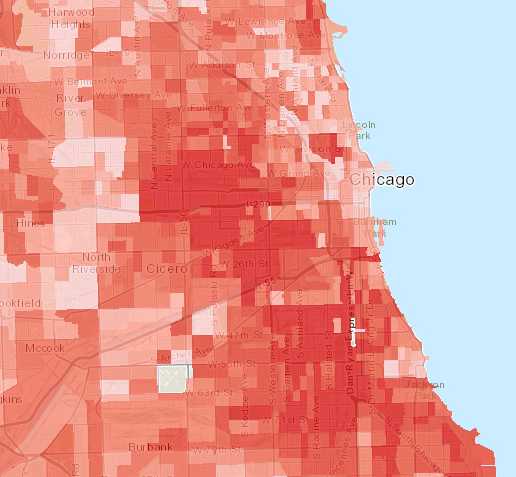
News, Events, & Research from the Integration Research Initiative

HUD recently created an interactive mapping tool that explores various indicators, like poverty mapped above, throughout the US.
As part of the Integration Research Initiative (IRI), a year-long project focused on racial and economic inequality and integration, the NYU Furman Center has convened a host of scholarly and policy-based events in early 2014 to advance the conversation about integration:
- As part of IRI’s Policy & Practice Series, we were joined on February 12th by John DeStefano, the former mayor of New Haven, Connecticut. He discussed his successful implementation of the Oak City ID cards for all New Haven residents, regardless of immigration status.
- On February 13th, Min Zhou, the Tan Lark Sye Chair Professor of Sociology at Nanyang Technological University and the Wang Endowed Chair in US-China Relations & Communications at UCLA, presented her paper entitled, “The Formation of Ethnic Resources and Social Capital in Immigrant Neighborhoods: Chinatown and Koreatown in Los Angeles.” Her paper seeks to develop a community perspective for explaining how neighborhoods are shared by ethnicity and how ethnic communities generate resources conducive to social mobility. During her talk, Professor Zhou spoke about the changing nature of ethnic enclaves: contemporary “ethnoburbs” have much higher levels of human and financial capital, albeit with lower levels of social capital, than prior Chinatowns.
- On February 6th, Roger Anderson, a current Straus Fellow, presented his research in a presentation entitled, “Segregation, Gentrification & Residualisation.” Anderson discussed the movement from public housing to market-driven housing allocation in inner city Stockholm.
In addition to our recent IRI events, there has been a great deal of research and news related to racial and economic inequality and integration. Here are some highlights:
- New York Schools Most Segregated in the Nation. A report released by UCLA’s Civil Rights Project finds that public school students in New York continue to be severely segregated. Public school students in the state are increasingly isolated by race and class as the proportion of minority and poor students continues to grow, according to the CRP report, “New York State’s Extreme School Segregation: Inequality, Inaction and a Damaged Future.” The study explores trends in enrollment and school segregation patterns from 1989 to 2010 at the state and regional levels, including the New York City metropolitan areas of Long Island and the New York City District, and the upstate metropolitan areas of Albany, Buffalo, Rochester, and Syracuse. [The Civil Rights Project, 3/26]
- Black, White, and Brown v. Board of Education: A Return to Segregated Schools? Nick News produced a documentary geared toward young viewers on the history of school segregation and a look at where we are now. The documentary featuring student interviews about the impacts of segregation in St. Louis, New Orleans and Hartford, Connecticut. [Nick, 2/11]
- Fighting segregation in housing: There’s a map for that. Lawrence Lanahan of Al Jazeera America reports on an effort by the U.S. Department of Housing and Urban Development (HUD) to update “a new interactive data map of race, class and opportunity.” [Al Jazeera, 2/5]
- How Bill de Blasio Can Fix NYC Housing. Reporter Matthew Yglesias writes that a construction boom “would reduce the trend toward gentrification and replace it with filtering,” that would allow economic integration to occur at a slower pace than rapid gentrification. [Slate, 2/11]
- How Busing Hurt Integration. Slate magazine launched a series “The Massive Liberal Failure on Race” leading with Tanner Colby, author of Some of My Best Friends Are Black: The Strange Story of Integration in America, on how the liberal embrace of busing hurt the cause of integration. [Slate, 2/4]
- Minnesota “Racially Isolated” Schools Enact 3rd Integration Plan. Two adjacent Minnesota school have finalized their third integration plan with funding from the state. Previous plans focused on increasing interactions among students with mixed results. Their new plan is instead focused on reducing the academic achievement gap and currently being evaluated by the state to ensure the program goals align with the new legislation. [Star Tribune, 2/1]
- Amsterdam’s Integrated Approach to Solving Segregation. University of Buffalo professor Carl Nightingale, author of Segregation: A Global History of Divided Cities, shares the story of how the Dutch sought to integrate Bijlmermeer, a housing project synonymous with poverty and crime. The solution was based in part on the idea that the purpose of demolition is not just to deconcentrate poverty. [Chicago, 1/14]
Learn more about the NYU Furman Center’s Integration Research Initiative, including The Dream Revisited series, and the 2013-2014 Straus Fellows.


